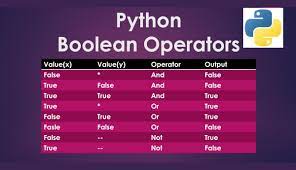3 Types of Boolean Operators in Python Examples (And|Or|Not)

Boolean operators in Python, including and, or, and not, perform logical operations on boolean values. and returns True if both operands are True, or returns True if at least one operand is True, and not returns the opposite boolean value of its operand. These operators are crucial for creating conditions in control flow structures, allowing developers to make decisions based on the truth or falsehood of expressions in their code.
What are Boolean Operators in Python?
Boolean operators in Python are used to perform logical operations on boolean values (True or False). The three main Boolean operators are and, or, and not. Here’s an explanation of each Python boolean operator list.
and:- The
andoperator returnsTrueif both operands areTrue; otherwise, it returnsFalse.
- The
x = True
y = False
result = x and y # Result will be False
2. or:
- The
oroperator returnsTrueif at least one of the operands isTrue; it returnsFalseonly if both operands areFalse.
x = True
y = False
result = x or y # Result will be True
3. not:
- The
notoperator is a unary operator that returns the opposite boolean value of its operand. If the operand isTrue,notreturnsFalse; if the operand isFalse,notreturnsTrue.
x = True
result = not x # Result will be False
These boolean operators are often used in conditional statements (if, elif, else) to control the flow of a program based on certain conditions. For example:
a = 5
b = 10
if a > 0 and b > 0:
print(“Both a and b are greater than 0”)
if a > 0 or b > 0:
print(“At least one of a or b is greater than 0”)
if not a == b:
print(“a is not equal to b”)
These examples illustrate how boolean operators can be applied to make decisions in your Python code based on the truth or falsehood of certain conditions.

Python boolean operators example:
Let’s go through some examples of using boolean operators in Python:
Example 1: and Operator
# Checking if both conditions are True
temperature = 25
is_sunny = True
if temperature > 20 and is_sunny:
print(“It’s a warm and sunny day!”)
else:
print(“It’s either not warm or not sunny.”)
In this example, the and operator is used to check if both conditions (temperature > 20 and is_sunny) are true.
Example 2: or Operator
# Checking if at least one condition is True
is_weekend = True
is_holiday = False
if is_weekend or is_holiday:
print(“It’s time to relax!”)
else:
print(“It’s a regular workday.”)
Here, the or boolean operators in python is used to check if at least one of the conditions (is_weekend or is_holiday) is true.
Example 3: not Operator
# Checking the opposite of a condition
is_raining = True
if not is_raining:
print(“No need for an umbrella.”)
else:
print(“Better grab an umbrella!”)
In this case, the not operator is used to check the opposite of the condition (is_raining).
Example 4: Combining Operators
# Combining multiple conditions
age = 25
has_license = True
if age >= 18 and has_license:
print(“You are eligible to drive!”)
else:
print(“You are either underage or don’t have a license.”)
Here, both the and and >= operators are used to check if a person is 18 years or older and has a driving license.
These examples demonstrate how boolean operators are used to make decisions and control the flow of a Python program based on different conditions.
How do you use Boolean operators in Python?
The operators for Boolean searches are and, or, and not. These operators let you make very specific or very general searches. It blends search phrases together so that every search result includes every term. Travel and Asia, for instance, return items that have both travel and Asia.
Is == a Boolean operator in Python?
No, the == the operator is not considered a boolean operator in Python. The == operator is a comparison operator used for equality comparison. It compares two values and returns True if they are equal, and False otherwise.
Here’s an example:
x = 5
y = 10
result = x == y # Result will be False

What are the Python Boolean Variables:
In boolean operators in python, a boolean variable is a variable that can take on one of two values: True or False. Boolean variables are commonly used in programming to represent the truth value of a condition or the result of a logical operation. Here’s how you can create and use boolean variables in Python:
Creating Boolean Variables:
# Example 1
is_sunny = True
is_raining = False
# Example 2
age_greater_than_18 = 22
is_adult = age_greater_than_18 > 18
In the first example, is_sunny and is_raining are boolean variables representing weather conditions. In the second example, is_adult is a boolean variable determined by comparing age_greater_than_18 to the value 18.
Using Boolean Variables in Conditions:
# Example 1
if is_sunny:
print(“It’s a sunny day!”)
# Example 2
if is_adult:
print(“You are an adult.”)
else:
print(“You are not yet an adult.”)
In the first example, the code inside the if the block is executed only if is_sunny is True. In the second example, the code checks the value of is_adult and prints a message accordingly.
Logical Operations with Boolean Variables:
# Example 1
is_weekday = True
is_workday = is_weekday and not is_sunny
print(“Is it a workday?”, is_workday)
# Example 2
has_free_time = True
can_go_out = is_sunny or has_free_time
print(“Can you go out?”, can_go_out)
In the first example, is_workday is determined by combining boolean variables using logical operators (and and not). In the second example, can_go_out is determined using the or operator.
Boolean variables and logical operations are fundamental concepts in programming, allowing you to create conditions and make decisions based on the truth or falsehood of statements.
How do you set a boolean variable to be false in Python:
In boolean operators in python, you can set a boolean variable to False by using the False literal. Here’s an example:
is_sunny = True # Setting it to True initially
# Some code…
is_sunny = False # Now setting it to False
In this example, the variable is_sunny is initially set to True. Later in the code, it is set to False to represent a change in the weather condition.
You can also directly initialize a boolean variable with the value False:
This creates a boolean variable named is_raining and initializes it with the value False. You can later update the value of the boolean variable based on your program’s logic.
Boolean variables are commonly used in various programming scenarios, including conditions, loops, and logical operations, to control the flow of the program.

How to assign boolean value in Python:
In boolean operators in Python, you can assign a boolean value by using the True or False literals. Here are examples:
Assigning True:
has_apples = True
is_sunny is assigned the boolean value True, indicating that it is currently sunny. Similarly, the variable has_apples is assigned the boolean value True.Assigning False:
has_oranges = False
In this example, the variable is_raining is assigned the boolean value False, indicating that it is not currently raining. The variable has_oranges is assigned the boolean value False.
You can use boolean values in various contexts, such as in conditional statements, logical operations, and more. For example:
if is_sunny:
print(“It’s a sunny day!”)
if not is_raining:
print(“It’s not raining, enjoy your day!”)
These examples demonstrate the use of boolean variables in simple conditional statements. Depending on the context of your program, boolean values can be used to control the flow of your code and make decisions.
In conclusion, boolean operators in Python (and, or, not) in Python are essential tools for logical operations on boolean values. They facilitate the creation of complex conditions, enabling developers to control program flow based on the truth or falsehood of expressions. The and operator checks if both operands are true, or checks if at least one is true, and not negates the boolean value. Mastery of boolean operators is fundamental for effective decision-making and conditional execution in Python programming.
See Also:
- Unveiling the Distinctions: Web Crawler vs Web Scrapers
- How to Make Money with Web Scraping Using Python
- How to Type Cast in Python with the Best 5 Examples
- Best Variable Arguments in Python
- 5 Best AI Prompt Engineering Certifications Free
- 5 Beginner Tips for Solving Python Coding Challenges
- Exploring Python Web Development Example Code
- “Python Coding Challenges: Exercises for Success”
- ChatGPT Prompt Engineering for Developers:
- How to Make AI-Generated Video|AI video generator
- 12 Best Python Web Scraping Tools and Libraries with Pros & Cons
- 7 Best Python Web Scraping Library To Master Data Extraction
- Explore the World of Character AI Generator





